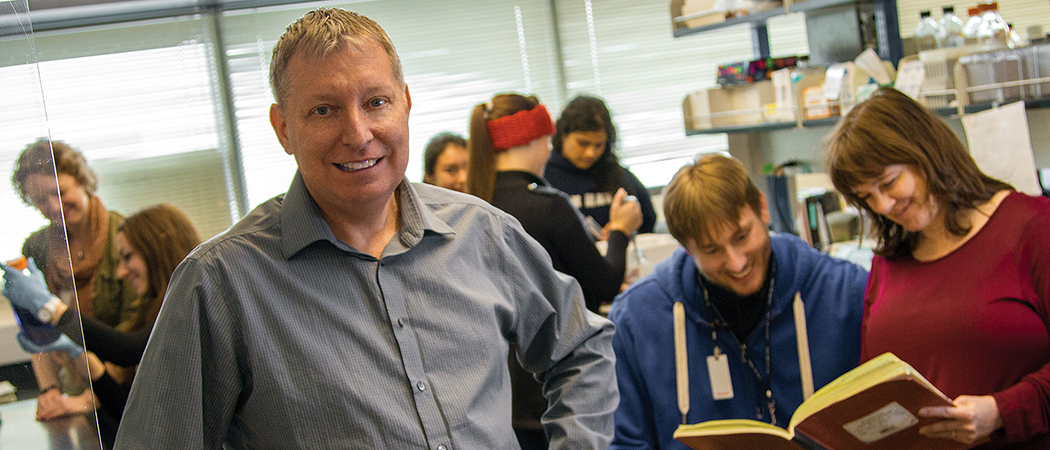Pioneering research by Professor Dean Burkin is at the center of strategic agreements between the University of Nevada, Reno, Prothelia Incorporated and Alexion, and may lead to a protein replacement therapy for a rare form of muscular dystrophy.
Burkin, a professor and pharmacological researcher with the University of Nevada School of Medicine, and his team discovered that administering laminin-111, a naturally occurring protein, prevents muscle damage in mouse models of muscular dystrophies. The therapy holds promise as a possible treatment for congenital muscular dystrophy in humans. The patented laminin-111 therapy was licensed to Prothelia in 2008.
Now, the three parties have entered into an agreement through which Alexion has an exclusive option to acquire privately held Prothelia and license laminin-111 directly from the University upon the achievement of specified research and development milestones. In addition, through Prothelia's introduction of Alexion to the University, the University and Alexion have entered into a sponsored-research agreement to accelerate further research on the patented therapy conditioned on the outcome of certain development research to be performed by Alexion.
"The pathway is now there to hopefully get this to a phase-one clinical trial," Burkin said. "Moving a discovery from the bench to the possibility of a therapeutic application and the treatment of patients is very exciting. I haven't even been able to sleep."
"My post docs and students have been working so hard," he continued. "Their work is represented here."
"Dr. Burkin has devoted much of his research to the treatment of muscular dystrophy, and this partnership and continued investigational research builds on his work," said Mridul Gautam, the University's vice president of research and innovation. "This partnership exemplifies the potential for university-based discovery and industry collaboration to create the possibility of bringing important advancements to the marketplace and ultimately bettering lives."
Congenital muscular dystrophy is a rare group of diseases that causes muscle weakness at birth. One form, known as MDC1A, is classified as an ultra-rare disease and is caused by a genetic defect that results in loss of the laminin-211 protein, which provides the necessary structural integrity to muscles. Patients with congenital muscular dystrophy suffer from respiratory insufficiency, poor muscle tone, muscle atrophy, delayed or absent motor skills, feeding difficulties, scoliosis and joint contractures. Respiratory infection is a common cause of morbidity and death.
Protein-replacement therapy is an expanding field resulting in new therapeutic options for muscular dystrophy and other diseases. In the case of MDC1A, the application of protein-replacement therapy means the protein laminin-111 would compensate for the genetic deficiency of the Laminin-211 protein. Since it is a naturally occurring protein it is less likely to be rejected by patients or give rise to side effects.
"This partnership with Alexion represents a significant step toward further investigating Laminin-111 as a potential treatment for MDC1A," said Richard Cloud, CEO at Prothelia. "We are confident that Alexion is the right partner, given their commitment to patients suffering from devastating, ultra-rare diseases like MDC1A."
Burkin's research has been published in the American Journal of Pathology, the Proceedings of the National Academy of Sciences, Science Translational Medicine and Neuromuscular Disorders. Jacinta Rooney, who worked in Burkin's lab as a graduate student and is now a post-doctoral scholar at the National Institutes of Health, contributed to the published findings.
Burkin co-hosted the Myomatrix 2012 conference which brought international scientists and clinicians to the University of Nevada, Reno campus to explore the latest findings and data related to congenital muscular dystrophy. His work has been profiled in the Better World Report, received funding from the Muscular Dystrophy Association and been applauded by Cure CMD, a national nonprofit organization dedicated to congenital muscular dystrophy research and education.
There are no approved therapies for those with congenital muscular dystrophy, and seeing experts and resources comes together, Burkin said, "gives patients and their families hope, especially when we are talking about rare diseases."
Burkin encourages those seeking information to contact the Muscular Dystrophy Association and Cure CMD for information about potential therapies, current clinical trials and patient registries. Registry information is especially important at this time since it contributes to advancements in science and pharmaceutical development.
"It is important to know who these patients are and how their disease has progressed," Burkin said of the patient registry effort.
For Gautam, Burkin's work is exemplary of the University's "world-class faculty" and research.
"Our University and School of Medicine faculty are at the cutting edge of biosciences discovery and innovation and bio-medical device development," he said. "The University, the University of Nevada School of Medicine, the entrepreneurial community in northern Nevada, the Governor's Office of Economic Development, the economic development agencies and the city of Reno are developing an innovation eco-system that is attracting companies, investors, entrepreneurs and innovators to the region, and this in turn further strengthens the research enterprise."
NevadaToday
Pharmaceutical company seeks to advance protein-replacement therapy discovery
Research by School of Medicine professor and mission to help those with rare form of muscular dystrophy are foundations for agreement between University, Prothelia and Alexion

Dean Burkin, a professor and pharmacological researcher with the University of Nevada School of Medicine, and his team discovered that administering laminin-111, a naturally occurring protein, prevents muscle damage in mouse models of muscular dystrophies.











